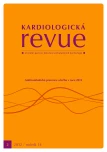Antiaggregating and anticoagulant therapy – basic principles
Authors:
M. Penka
Authors‘ workplace:
OKH FN Brno
Published in:
Kardiol Rev Int Med 2012, 14(2): 63-67
Overview
Thrombosis and thrombembolism takes very important place in medicine, because they appears to the most important cause of morbidity and mortality of the patients at all. Thrombembolic events can be of different provenience and of different types and it is possible to meet them in all the regions of the medicine. It is not surprising, that new drugs are developing for long time to affect and prevent of thrombembolic complications more and more effectively. That is also because the concentrating effort is underline by this fact, that the problem is mainly the problem of developed part of the world, where the research has all the assumption to pay appropriate attention. New drugs are developed, new possibilities of their monitoring and new algorithms – all in context with lot of studies, which are to this problem dedicated.
Keywords:
thrombosis – antithrombotics – antiaggregating drugs
Sources
1. Furie B, Furie BC. Mechanisms of trombus formation. N Engl J Med 2008; 359: 938–949.
2. Turpie AG, Esmon C. Venous and arterial thrombosis – pathogenesis and the rationale for anticoagulation. Thromb Haemost 2011; 105: 586–596.
3. Kvasnička J. Trombofilie a trombotické stavy v klinické praxi. Praha: Grada- Avicenum 2003: 13–299.
4. Gross M, Greenberg LA. The Salicylates: a critical bibliographic review. New Heaven: Hillhouse Press 1948.
5. Ji X, Hou M. Novel agent for anti-platelet therapy. J Hematol Oncol 2011; 4: 3–7.
6. Iyú D, Glenn JR, White AE et al. Mode of action of P2Y(12) antagonists as inhibitor of platelet function. Tromb Haemost 2011; 105: 96–106.
7. López JA, Kearon C, Lee AY. Deep venous thrombosis. Hematology Am Soc Hematom Educ Program 2004: 439–456.
8. Widimský J, Malý J. Akutní plicní embolie a žilní trombóza. Praha: Triton 2002; 7–303.
9. Mackman N. Triggers, targets and tretaments for thrombosis. Nature 2008; 451: 914–918.
10. Kessler P. Léčba orálními antikoagulancii. Praha: Orion-Pharma Oyj 2002: 1–64.
11. Gross PL, Weitz JI. New antithrombotic drugs. Clin Pharmacol Ther 2009; 86: 139–146.
12. Perzborn E. Factor Xa inhibitors – new anticoagulants for secondary haemostasis. Hamostaseologie 2009; 29: 260–267.
13. Gross PL, Weitz JI. New anticoagulants for treatment of venous thromboembolism. Aterioscler Thromb Vasc Biol 2008; 28: 380–386.
14. Bounameaux H, Reber G. New oral antithrombotics: a need for laboratory monitoring. Against. J Thromb Haemost 2010; 8: 627–630.
15. Penka M, Gumulec J, Buliková A et al. Monitorování perorální antikoaulační léčby v ambulantní praxi. Kardiol Rev 2007; 9: 159–164.
16. Eerenberg ES, Kamphuisen PW, Sijpkens MK et al. Reversal of rivaroxaban and dabigatran by prothrombin complex concentrate: a randomized, placebo-controlled, crossover study in healthy subjects. Circulation 2011; 124: 1573–1579.
17. Watson T, Shantsila E, Lip GY. Mechanisms of thrombogenesis in atrial fibrilation: Virchow’s triad revisited. Lancet 2009; 373: 155–166.
18. Antithrombotic and thrombolytic therapy. American College of Chest Physicians Evidence-Based Clinical Practice Guidelines (8th ed). Chest 2008; 133: 67–968.
19. Fukuda T, Honda Y, Kamisato C et al. Reversal of anticoagulant effects of edoxaban, an oral, direct factor Xa inhibitor, with haemostatic agents. Thromb Haemost 2012; 107: 253–259.
Labels
Paediatric cardiology Internal medicine Cardiac surgery CardiologyArticle was published in
Cardiology Review

2012 Issue 2
Most read in this issue
- Antiaggregating and anticoagulant therapy – basic principles
- Anticoagulant therapy and atrial fibrillation
- Where is a step in the current development of drugs that affect blood clotting?
- Current guidelines for antiplatelet therapy in neurology
